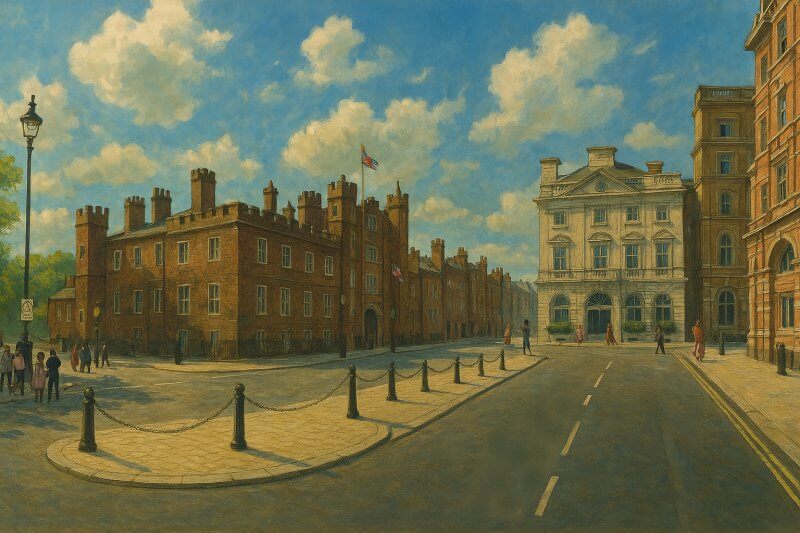
St James's London
St James's, London: History, Elegance and Royal Heritage in Westminster
St James's is a historic and prestigious district in the heart of the City of Westminster, central London. Nestled just west of Trafalgar Square and north of Buckingham Palace, St James's forms part of an illustrious neighbourhood bordered by:- Mayfair to the northwest
- Green Park and Buckingham Palace to the southwest
- Westminster proper (including Whitehall and Parliament) to the southeast
- Soho to the northeast
Size and Population
St James's is a relatively small area, covering roughly 0.25 square miles (0.65 square kilometres). Despite its compact size, it plays an outsized role in the culture and administration of the capital. The residential population is low - estimated at fewer than 1,000 permanent residents - owing to the area's dominance by commercial buildings, clubs, government offices, embassies, and royal parks. However, its daytime population surges with tourists, workers, and visitors.A Glimpse into the History of St James's
The origins of St James's stretch back to the medieval period, but the area as we know it today began to take shape in the 17th century. Before urban development, the land was primarily open fields and marshland situated on the edge of Westminster. Its transformation began with the establishment of St James's Palace by Henry VIII in the 1530s on the site of a former leper hospital dedicated to St James the Less (not to be confused with James the Apostle). The surrounding area, originally farmland and hunting grounds, gradually developed into an aristocratic residential quarter through the 17th and 18th centuries. By the 1660s, the Restoration period saw the development of St James's Square, which became one of London's most fashionable addresses. Over time, it evolved into a hub for exclusive gentlemen's clubs, elegant shops, and royal establishments.How St James's Got Its Name
The name St James's comes from the 12th-century Hospital of St James, a leper hospice dedicated to St James the Less, one of the twelve apostles. Unlike the Camino de Santiago pilgrimage route in Spain, St James's was never a major pilgrimage destination, but its name reflects a biblical association and the Christian charitable tradition of caring for the sick.Main Roads in St James's
St James's is defined by a number of grand and historic streets that still retain their charm and importance today:- Pall Mall - home to many gentlemen's clubs and formerly a royal road.
- St James's Street - a key thoroughfare running south from Piccadilly to St James's Palace.
- Piccadilly - forming the northern boundary of St James's.
- Jermyn Street - renowned for bespoke shirtmakers and high-end menswear tailors.
- King Street - connecting St James's Square with St James's Street.
Map of St James's, London
Streets of St James's, London
- Apple Tree Yard
- Bury Street
- Carlton Gardens
- Carlton House Terrace
- Catherine Wheel Yard
- Charles II Street
- Cleveland Row
- Duke of York Street
- Duke Street St James's
- Jermyn Street
- King Street
- Little St James's Street
- Man In Moon Passage
- Marlborough Road
- Mason's Yard
- Ormond Yard
- Pall Mall
- Park Place
- Piccadilly
- Piccadilly Circus
- Piccadilly Place
- Regent Street St James's
- Russell Court
- Ryder Street
- St James's Place
- St James's Square
- St James's Street
- The Mall
- Waterloo Place
Shopping in St James's
The Character of St James's
St James's is a district that exudes elegance, prestige, and tradition. It is:- Commercial - home to exclusive offices, auction houses, and art galleries.
- Retail-focused - especially high-end menswear, art, and fine wine.
- Institutional - with many clubs, royal residences, and cultural institutions.
- Semi-residential - but with very limited housing stock.
Major Sights and Attractions in St James's
St James's is rich in heritage and attractions, many of which are iconic London landmarks. Highlights include:- St James's Palace - a working royal residence and the formal home of several royal family members.
- St James's Park - one of the loveliest Royal Parks, with views of Buckingham Palace and waterfowl-rich lakes.
- The Mall - the ceremonial road leading to Buckingham Palace, used for royal processions and parades.
- Spencer House - an 18th-century aristocratic mansion open to the public on Sundays.
- St James's Square - a peaceful garden square surrounded by historic buildings.
- The Royal Academy of Arts - located just outside St James's, on Piccadilly, but integral to the cultural fabric of the area.
- Jermyn Street - perfect for shopping aficionados, with tailors and perfumers dating back centuries.
Nearest London Underground Stations
St James's is well-served by several London Underground stations:- Green Park Station - serving the Jubilee, Piccadilly, and Victoria lines.
- Piccadilly Circus Station - on the Piccadilly and Bakerloo lines.
- Charing Cross Station - on the Northern and Bakerloo lines (a short walk away).
- St James's Park Station - on the District and Circle lines, though technically closer to Westminster.
Fun Fact: The Origins of Gentlemen's Clubs
St James's is famously home to many of London's oldest and most exclusive gentlemen's clubs. These private members' clubs, such as White's, Boodle's, and the Reform Club, have their roots in the 18th and 19th centuries and were founded as places where aristocratic men could gather to socialise, drink, and discuss politics in privacy. Even today, many of these clubs maintain their traditions and strict dress codes.
Painting of St James's